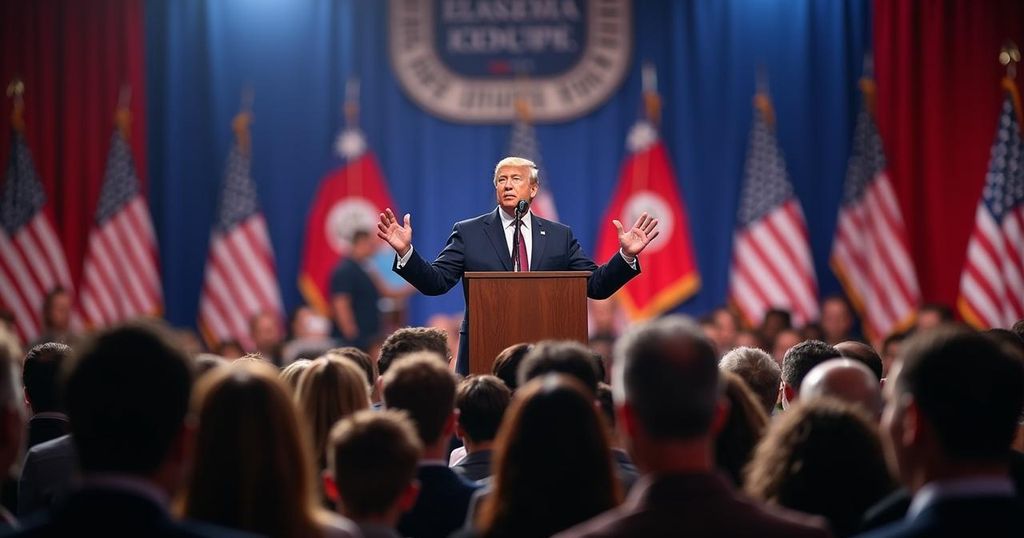On October 14, 2024, Vice President Kamala Harris and former President Donald Trump campaigned in Pennsylvania, addressing different regions of the state. Harris critiqued Trump’s rhetoric on military intervention against political opposition, while Trump focused on energizing his base. Both candidates emphasized Pennsylvania’s economic issues, especially related to the energy sector, as they vie for undecided voters in this pivotal battleground state.
On October 14, 2024, Vice President Kamala Harris and former President Donald Trump campaigned across Pennsylvania, a pivotal state in the presidential election. Vice President Harris addressed supporters in Erie, located in the northwest region of the state, whereas Mr. Trump held a town hall event in Oaks, near Philadelphia in the southeast. This marked Harris’s tenth visit to Pennsylvania during this campaign and Trump’s continued effort to rally his base after making appearances in Scranton and Reading the previous week. In her speech, Harris focused on condemning Trump’s remarks about utilizing military intervention against domestic dissenters, characterizing it as a threat to American democracy. A senior campaign official stated that Harris intends to emphasize how Trump views dissenting Americans as adversaries. Her rhetoric further aims to alarm voters by suggesting that a second term for Trump could lead to increased authoritarianism. Trump, responding to inquiries about potential Election Day disruptions, labeled his political opponents as ‘the enemy from within,’ referencing, in part, the radical left. He posited that such individuals posed a significant threat, which, if necessary, could warrant intervention by the National Guard or even the military. Both candidates are expected to discuss issues pertinent to Pennsylvania’s economy, particularly its energy sector and natural gas fracking, as they seek to convince undecided voters. More than seven million people are predicted to vote in Pennsylvania, a state Trump narrowly won in 2016 and lost in 2020. Harris highlighted the potential importance of Erie, a Democratic-leaning city with a history of moderate outcomes in elections, and indicated her plans to criticize Trump’s limited disclosures regarding his health history, especially as he is the oldest presidential nominee to run at 78. Additionally, Harris intended to promote early voting and illustrate her commitment to bolstering economic opportunities for Black men by visiting a Black-owned business prior to her rally. Meanwhile, Trump aimed to energize his supporters by facilitating a town hall meeting, reflecting a growing enthusiasm for his campaign. As both candidates mobilize their campaigns in Pennsylvania, they underscore the significance of this state, which boasts the highest electoral vote count among swing states. The competing strategies exemplify the broader national dynamic as they each vie for voter support in a state crucial to both parties’ electoral futures.
The article discusses a significant day in the 2024 U.S. presidential campaign, focusing on the activities of Vice President Kamala Harris and former President Donald Trump in Pennsylvania—one of the largest battleground states. Their campaigns highlight opposing views on key issues, especially concerning national security, democracy, and economic policies linked to state-specific interests, such as natural gas and energy production. The importance of Pennsylvania is emphasized, given its role in previous elections and its potential impact on the final vote count, amidst ongoing discussions about voter sentiment and turnout strategies as election day approaches.
In summary, the campaign efforts of Vice President Kamala Harris and former President Donald Trump in Pennsylvania signify the crucial nature of this battleground state in the 2024 election. Their contrasting messages on national security and economic policy aim to appeal to undecided voters. Harris intends to focus on potential threats posed by Trump’s rhetoric, while Trump seeks to galvanize support based on his prior achievements and economic concerns that resonate with many constituents. As both candidates prepare for the upcoming election, their strategies reflect a broader contest for voter allegiance in key states.
Original Source: apnews.com






